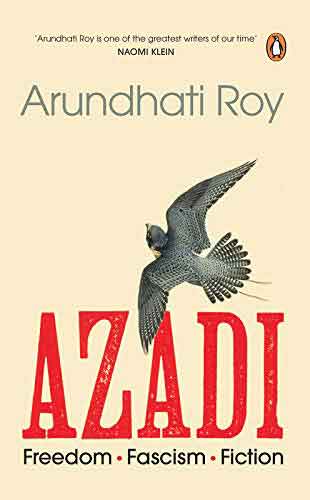
‘What lies ahead?
Reimagining the world. Only that.’
With these above lines, Arundhati Roy ended her introduction and they reflect what Roy set out to do in the book ‘Azadi: Freedom. Fascism. Fiction’. In the nine essays in this book, most of which are previously published or given as lectures between 2018 and 2020, Roy explores the important events of this time occurring in India, which are culminating towards, what Roy calls, ‘The Rise and Rise of Hindu Nation’, whose influences are “spreading like an epidemic and blossoming in the popular imagination like a brain-deadening malignancy”. She captures this complex malignancy and the difficulties it poses to the language in order to explore it in its totality.
Roy wrote vividly on events that are happening in India which are having a devastating impact of certain sections of the population, particularly Muslims, Dalits, student activists and intellectuals voicing against those in power, like the Delhi riots whose real perpetrators, eventhough caught on camara delivering inflammatory speeches, are not even listed in the FIR and never will, arrests of the intellectuals and activists who are voices of poor and marginalised like Sudha Bharadwaj, Arun Ferreria, Veron Gonsalves, Varavara Rao, Gautam Navlakha and many others in connection with plotting violence at Bhima-Koregaon and further plotting to kill Prime Minister, abrogation of Article 370 and 35A, complete lockdown in Kashmir valley and brutality of armed forces against their own citizenry that followed, Assam’s NRC and planned national wide CAA and NPR, arrests of people under draconic Unlawful Activities Prevention Act, and inaction of the state towards anarchic sloganeering by members of the ruling party, some of them in central ministries like ‘Mussalman ka ek ki sthan, Kabristan ya Pakistan!’-Only one place for the Mussalman, the graveyard or Pakistan. She also delves into exploring the impact of demonetisation and GST, which had a devastating impact on the small and medium scale industries, benefitting big capitalists.
According to Roy, all the issues that are stated above and many more are used by the ruling party to incite fear and win the power. She writes, “In order to consolidate their political gains, the RSS and BJP’s main strategy is to generate long-lasting chaos on an industrial scale. They have stocked their kitchen with a set of simmering cauldrons that can, whenever necessary, be quickly brought to the boil”.
Apart from writing about the language of politics, Roy also reflects on the politics of language. In the first essay in this collection titled ‘In What Language Does Rain Fall over Tormented Cities’, she wrote about her growing up in different regions of India, and growing up with different languages. This awareness of beauty and limits of different languages, Roy assets the threats that are posed by the Hindutva forces by imposing a single language on whole India, a nation of ‘multiple mutinies’, a term used by VS Naipaul to describe the diverse subcontinent. This reminds the reader of George Orwell’s dystopian novel ‘1984’ in which Orwell describes how in his imaginary country ‘Oceania’, words in the language are removed every single moment to cut the conception of people because individual’s consciousness is limited by their language. Roy finds a similar project ongoing in India. But the Indian case is more complex than Orwell’s Oceania. In order to comprehend the threats posed to language in India, Roy uses the phrase the ‘Project of Unseeing’.
This ‘Project of Unseeing’, Roy argues, works in myriad ways. One one side, with continuous repression of people by the state using the colonial time’s laws, the state induced fear in the people, thus forcing them not to speak the truth and live in an illusion of believing the myths proclaimed by those in power. Secondly, we are trapped into believing the lies promulgated by the Hindu nationalists. Roy observed that “the history being paddled by Hindu nationalists, that hackneyed tale of spurious valour and exaggerated victimhood in which history is turned into mythology and mythology into history”. Hindu nationalists want to rewrite the history and juxtapose the past realities with nonsensical fiction. This reflects the fear of those mythmakers to face the truths of the past. “The only good thing to be said of this contemporary mob tradition is that it understands the dangers posed by art” and it tries to do anything to destroy the truth-speaking art.
Reflecting on the responsibilities of literature, Roy claims that in order to counter the opposition posed by the hegemonic, authors have to make the new language. She writes, “For me, or for most contemporary writers working in these parts, language can never be a given. It has to be made. It has to be cooked. Slow-cooked”. Arundhati Roy wrote only two works of fiction till date and her focus has been in nonfiction writing. But to disseminate and comprehend the complexities in India, Roy emphasises on the importance of fiction. For Roy, it is fiction that “has the capaciousness, the freedom and latitude, to hold out a universe of infinite complexity”. In her essay, ‘The Graveyard Talks Back’, she reflected on her idea of fiction and how she uses it to capture things which haunt her and things that can’t be expressed through numbers and facts. Roy took the case of Kashmir, a beautiful valley which is now “covered with graveyards, and in this way has become, literally, almost a graveyard itself”. The story of Kashmir and Kashmiris, particularly in the past thirty years in general, as shown in the media is not just the story of curfew, terror, deaths, rigged elections and human right violations. It is a story of “love and poetry, too. It cannot be flattened into news”. This truth about Kashmir can be told only through fiction “because only can tell about air that is so thick with fear and loss, with pride and mad courage, and with unimaginable cruelty. Only fiction can try to describe the transactions that take place in such a climate”.
Roy culminates all her thoughts in her final essay in this collection, which is about the hope to enter a new world. Roy sees the present global pandemic as a portal, “a gateway between one world and the next”. This pandemic brought out the fragile and inhuman nature of the world order. Though the virus is egalitarian, which does not differentiate between people it wants to attack, the system dealt with the pandemic by duly respecting all the religious, caste and class prejudices. But this pandemic offers hope, a chance to reimagine the world. Roy places her in the people “who are prepared to be unpopular. Who are prepared to put themselves in danger. Who are prepared to tell the truth” to lead the nation into the newer world taking it away from evil forces that are trying to damage the vibrancy of plural, secular and democratic India.
Walter Benjamin once said, “The storyteller is the figure in which the righteous man encounters himself”. Roy is one such a storyteller. Her essays are reflective, introspective, critical and provoke the readers to think anew about the world we are living in. We may agree or disagree with her opinions. But they will inevitably paint new colours to our imagination and equips the readers for their journey in ‘reimagining the world’.
Before ending, Arundhati Roy leaves her readers with a note of hope and despair- “We can only hope that, someday soon, the streets in India will throng with people who realize that unless they make their move, the end is close. If that doesn’t happen, consider these words to be intimations of an ending from one who lived through these times”.
Mucheli Rishvanth Reddy is currently pursuing final year in BA Economics, Political Science and Sociology at Christ University, Bangalore. Mail Id: [email protected]
SIGN UP FOR COUNTERCURRENTS DAILY NEWSLETTER

















































